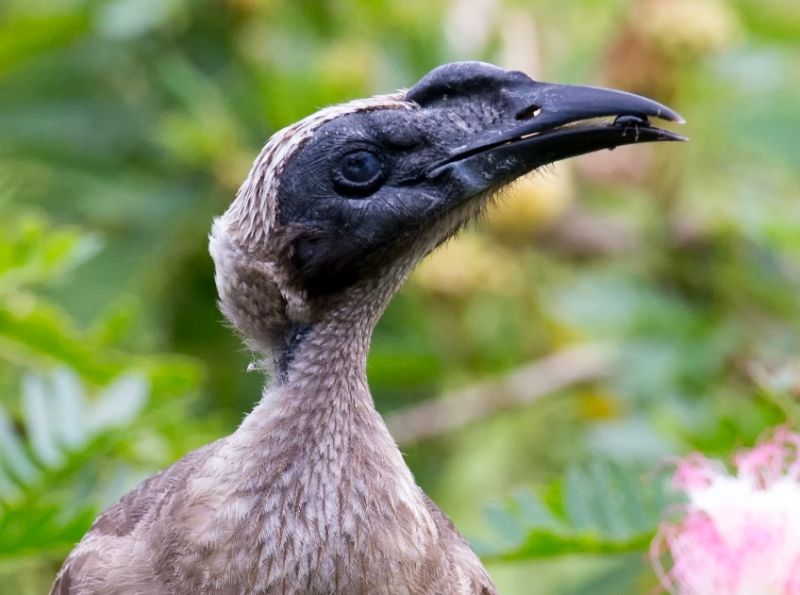Habitat: The helmeted friarbird (Philemon buceroides) is one of the largest Australian friarbirds. The Helmeted Friarbird is a bird of the rainforest edge, wherever it occurs throughout its vast range, from New Guinea across northern Australia to the Lesser Sundas. Flight from tree to tree is erratically undulating. The tail flirts above and about, giving the impression that the bird is being blown along by the wind. They also dive down to bathe in pools and spend much time preening afterwards.
When not breeding, the friarbirds wander locally by day before returning to the rainforest to roost in the canopy. Their monotonous, mournful dual-note cries, often rendered by poor devils, denote their positions at dusk and when waking at dawn.
Breeding: During breeding, pairs are more sedentary and secretive near the nest site. When the nest is being built, the female sometimes works closely with other species of birds, tearing off bark from trees and flying back with them following behind. Pairs advertise their breeding and feeding territory by cackling duets sporadically throughout the day. Other birds may join in as well.

Identification: Both sexes are similar; males are larger. Crown, lightly tufted nape, back, wings, and tail fawn-brown to mid-brown. The sides of the face of bare, slaty black skin; ear coverts are dusky-haired. Throat and breast of silvery brown scale-like feathers with dark shafts; belly to undertail is fawn-brown.
The eyes are dark red. The bill is black with small to large bulbous knobs. The feet are slate-grey. The immature bird’s back, shoulders, and rump are edged white; the edges of flight and tail feathers are washed with citrine; the throat and breast are washed with yellow; and the bill is knob-small. Juveniles before their first annual molt two or three months after fledging as adults but fluffier; throat unscaled; and eyes are brown.
Vocalizations: The helmeted Friarbird call is a mournful, double-note, down-slurred chant, Poor Devil, as a position call mainly at dawn and dusk. Also chilling are cackles and squawks during fighting and feeding site advertisements. The song consists of a series of measured cackles, guttural wails, and clanking’s, often by both sexes in duet or antiphonally.
Diet: It does feed into fringing eucalypt woodlands in northern Queensland and streamside galleries of paperbark Melaleuca in Arnhem Land. Helmeted friarbirds feed in the upper strata of trees and aggressively chase off any poachers. They usually forage alone or in pairs, but sometimes congregate noisily in blossoming trees in groups of 12–30.
At times they flutter, cackle, and squabble boisterously in the canopy foliage, and at others they sit quietly feeding among the leaves, picking up a range of insects, spiders, fruit, and nectar. They also hawk out to catch insects on the wing, particularly termites, but eat more fruit than other friarbirds. Fruits, seeds, and nectar are their main sources of nutrition. On rare occasions, they will eat invertebrates and lizards, but the basic details of their diet will vary according to their location.

Nesting: It commonly frequents nests in mangroves along the Darwin coast, but nowhere is it ever far from core pockets of rainforest and monsoon vine thickets. Nesting and breeding occur in August–January, sometimes later. Nests are a loose, bulky cup of bark strips and occasionally leaves, interwoven with vine tendrils and twigs; lined with fine tendrils and twigs; situated on a well-camouflaged outer limb or in fork among foliage; 2–14 meters above the ground. These birds tend to build their nests habitually close to a body of water and high in trees to avoid harm.
Eggs and Incubation: Helmeted Friarbird lays one to five eggs (usually two or three); cream to light pink, closely freckled and blotched with red-brown, purple-red, and lilac-grey; tapered-oval, about 34 x 23 mm. Incubation is responsible for females. She incubates the eggs while the male stays close by. Both sexes feed on the young.
Alternative Names: It is also known as Melville Island Friarbird and Sandstone Friarbird.
Size and Weight: The Helmeted Friarbird is about 320–360 mm (32–36 cm) long. They weigh in at 91–111 g for females and 128–178 g for males, with an average measurement of about 37–38 cm.
Life Span: The average life span of this bird is about 6–7 years.
Family: The Helmeted Friarbird is part of the honeyeater family Meliphagidae in the order Passeriformes.
Races: There are about 10 races; only three are found in Australia.
Status: The population is stable right now; however, it may reduce by about 10% in the next decade. Hence, it is being considered a danger, as numbers are declining in the next 30 to 40 years.
Distribution: The Helmeted Friarbird is prominently abundant on Melville Island, NT, and adjacent mainland in mangroves, monsoon forests, and paperbark swamps; western Arnhem Land from Oenpelli to Mary River in broad-leafed gullies and creek courses; and coastal Queensland from Cape York to Sarina at low altitudes. Also found in Papua New Guinea and the Lesser Sundas.
Read More: Silver-crowned Friarbird (Philemon argenticeps)







